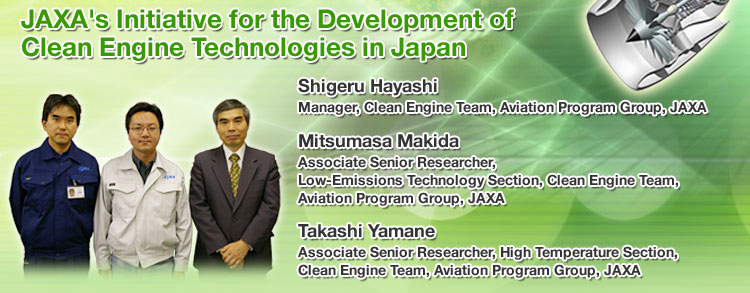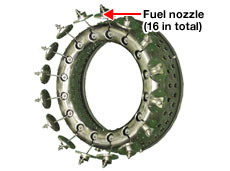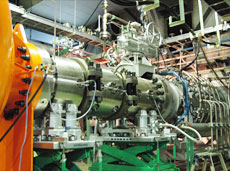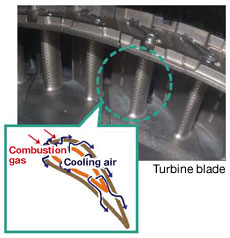

Q. What are the essential technologies required for "Clean Engine"?
Hayashi: Our targeted "Clean Engine" should emit less carbon dioxide (CO2) and nitrogen oxides (NOx) to alleviate of global warming issues, and be quiet enough to mitigate noise annoyances in the vicinity of airports. We are developing fan and jet noise reduction technologies, low NOx combustion technologies, and effective turbine-cooling technologies to reduce CO2 emissions. Additionally, material technologies, Computational Fluid Dynamics (CFD) design technology, and integrated engine systems are also being developed.

Full annular combustor

High-Temperature, High-Pressure Combustion Test Facility

Q. To attain these technologies, specifically what kind of research is being conducted at JAXA?
Makida: I am developing a combustor with reduced NOx emissions. In a jet engine combustor, NOx are byproducts produced when fuel is burned at high temperature and pressure. The higher the operating temperature and pressure of the engine, the higher the engine efficiency, but at the same time the NOx emissions are higher as well. In newly developed large-scale engines, the temperature and pressure at the combustor inlet are very high, increasing NOx emissions accordingly. To reduce these emissions, we have to manipulate the following items: 1) fuel injection from fuel nozzles; 2) air and fuel mixing; and 3) the size and arrangement of air holes that send air into the combustion chamber. We are also developing combustion technologies using the Lean Premixed Prevaporized (LPP) method, which suppresses the formation of NOx by decreasing the combustion temperature.
A combustor test requires an environment that's as realistic as possible, so we developed and upgraded the High-Temperature, High-Pressure Combustion Test Facility in 2006, and the Full Annular Combustor Test Facility in 2007. In the High-Temperature, High-Pressure Combustion Test Facility, the performance of tubular and sector combustors can be tested in an environment that simulates the inside of an engine. With the Annular Combustor Test Facility, we can test 50-cm diameter class annular (doughnut-shaped) combustor at simulating temperature and pressure conditions inside an engine. At both facilities, we can closely observe what's happening inside the combustor. So, for example, it's possible to monitor whether all fuel nozzles are firing in the same manner. For the annular combustors, we can obtain data on temperature, pressure and composition of exhaust gases using a measuring device which rotates 360 degrees at the exit.
Hayashi: Another feature of our facilities is the use of electricity to heat the air. At large-scale facilities, it is generally common to use oil or gas fuel heaters for this purpose. But at our facilities, the use of an electric heating provides good temperature control, allowing us to adjust the temperature in one-degree increments. This is very important because the amount of NOx emissions is very sensitive to the inlet air temperature. Because of these features, JAXA's test facilities are attracting attention not only from Japanese aeroengine manufacturers but also from companies and universities overseas. We are collaborating with them on researches at our facilities, and I expect that the number of international collaborative projects will increase. As a public agency, JAXA is supporting private-sector businesses with new technologies and concepts. Keeping in mind that JAXA and the private sector have separate roles, we'd like to continue to collaborate on the development of advanced technology.
Today, the New Energy and Industrial Technology Development Organization (NEDO) is promoting a project called the Research and Development for an Environment-friendly Small Aircraft Engine (the ECO Engine Project), started in 2003. Its goal is to develop and commercialize environmentally compatible engines at Japan's initiative. One of the technical items in this project is the development of a combustor with reduced NOx emissions. Since JAXA is responsible for technical support, I think that our test facilities will be imperative for this project.

Measured value of exhaust gas from combustor compared with standard and target values
Makida: It was challenging to develop such advanced facilities. But it is unquestionably worthwhile, as they allow us to move development along much faster and more efficiently. The International Civil Aviation Organization (ICAO) regulates nitrogen oxides (NOx), hydrocarbon and carbon monoxide emissions from aircraft engines during landing, taxiing, idling and takeoff. In NEDO's ECO Engine project, development of combustor technology is underway, with the aim of cutting NOx emissions by more than 50-per-cent from the CAEP/4 standard set at the 4th meeting of ICAO's Committee on Aviation Environmental Protection. In 2006, JAXA has achieved about 60-per-cent reduction from the ICAO CAEP/4 standard. ICAO has been tightening it's regulations almost every three years, so keeping this in mind, we should continue to make efforts toward further reduction of NOx. Also, new NOx reduction technology is being developed to achieve 80-per-cent reduction of NOx emissions from the CAEP/4 standard by 2012.

Turbine blade cooling structure

Spin burst test of composite turbine disk

Q. Could you describe your research, Dr. Yamane?
Yamane: I am developing turbine cooling technology to improve fuel efficiency and reduce carbon dioxide emissions from aircraft engines. In a jet engine, the turbine is a rotating machine that produces power. The power is generated by a rotor with more than 40 blades turning in response to high temperature and highly pressurized gas.
Engine performance is enhanced when pressure into the combustor is increased, but at the same time it is necessary to raise the combustion temperature in order to achieve top efficiency. With the combustors on the market now, the combustion gas temperature reaches more than 1500°C, and will be over 1600°C in the future. However, the turbine blades are made of a metal that can withstand temperatures of only 1100°C. To prevent the blades from melting, engines have been built with a cooling component, so that the turbine blades do not reach 1000°C. Currently, turbine blades are cooled by a stream of air from the compressor, which reaches the turbine blades without passing through the combustor. The more air is used, the better the turbine can be cooled. But the challenge is that this lowers engine performance, since air that is being used for cooling the turbine is thus not available to be used for combustion to generate energy. Thus, if we reduced the current volume of cooling air by half and redirected that air to the combustor, we estimate that overall engine efficiency would increase by about 2 per cent. This may not sound like a lot, but 2 per cent of a full tank of fuel for a jumbo jet is worth several hundred thousand yen. It is a significant sum for air carriers, which spend huge amounts of money on fuel. So we are currently studying efficient cooling structures for turbine blades that require as little air as possible.
Meanwhile, we are conducting research on new turbine blades made with more heat-resistant materials, such as a nickel-base superalloy, a high-melting-point alloy, and ceramics. The materials are being developed at the National Institute for Materials Science (NIMS). Our role at JAXA is to evaluate their durability and strength at high temperatures that simulate actual jet engine environments.
Hayashi: Noise reduction technology is also imperative to developing a clean engine. To minimize jet engine noise, we first have to identify its source, and then build sound-absorbing devices based on its acoustic properties. To do this, we need to develop measurement technology to investigate the acoustic characteristics around the engine. We have successfully tested an experimental noise suppressor with an experimental jet engine. Noise can also be reduced by changing the configuration of an engine. For example, by testing engines with variable exit nozzles, we can study the effect of noise suppression on thrust. Furthermore, with CFD analysis, we can design and evaluate the configurations of engine mixers and fans, which are the main sources of engine noise. So we are approaching the research on noise reduction technology from various directions.
Hayashi: Our targeted "Clean Engine" should emit less carbon dioxide (CO2) and nitrogen oxides (NOx) to alleviate of global warming issues, and be quiet enough to mitigate noise annoyances in the vicinity of airports. We are developing fan and jet noise reduction technologies, low NOx combustion technologies, and effective turbine-cooling technologies to reduce CO2 emissions. Additionally, material technologies, Computational Fluid Dynamics (CFD) design technology, and integrated engine systems are also being developed.

Full annular combustor

High-Temperature, High-Pressure Combustion Test Facility
Q. To attain these technologies, specifically what kind of research is being conducted at JAXA?
Makida: I am developing a combustor with reduced NOx emissions. In a jet engine combustor, NOx are byproducts produced when fuel is burned at high temperature and pressure. The higher the operating temperature and pressure of the engine, the higher the engine efficiency, but at the same time the NOx emissions are higher as well. In newly developed large-scale engines, the temperature and pressure at the combustor inlet are very high, increasing NOx emissions accordingly. To reduce these emissions, we have to manipulate the following items: 1) fuel injection from fuel nozzles; 2) air and fuel mixing; and 3) the size and arrangement of air holes that send air into the combustion chamber. We are also developing combustion technologies using the Lean Premixed Prevaporized (LPP) method, which suppresses the formation of NOx by decreasing the combustion temperature.
A combustor test requires an environment that's as realistic as possible, so we developed and upgraded the High-Temperature, High-Pressure Combustion Test Facility in 2006, and the Full Annular Combustor Test Facility in 2007. In the High-Temperature, High-Pressure Combustion Test Facility, the performance of tubular and sector combustors can be tested in an environment that simulates the inside of an engine. With the Annular Combustor Test Facility, we can test 50-cm diameter class annular (doughnut-shaped) combustor at simulating temperature and pressure conditions inside an engine. At both facilities, we can closely observe what's happening inside the combustor. So, for example, it's possible to monitor whether all fuel nozzles are firing in the same manner. For the annular combustors, we can obtain data on temperature, pressure and composition of exhaust gases using a measuring device which rotates 360 degrees at the exit.
Hayashi: Another feature of our facilities is the use of electricity to heat the air. At large-scale facilities, it is generally common to use oil or gas fuel heaters for this purpose. But at our facilities, the use of an electric heating provides good temperature control, allowing us to adjust the temperature in one-degree increments. This is very important because the amount of NOx emissions is very sensitive to the inlet air temperature. Because of these features, JAXA's test facilities are attracting attention not only from Japanese aeroengine manufacturers but also from companies and universities overseas. We are collaborating with them on researches at our facilities, and I expect that the number of international collaborative projects will increase. As a public agency, JAXA is supporting private-sector businesses with new technologies and concepts. Keeping in mind that JAXA and the private sector have separate roles, we'd like to continue to collaborate on the development of advanced technology.
Today, the New Energy and Industrial Technology Development Organization (NEDO) is promoting a project called the Research and Development for an Environment-friendly Small Aircraft Engine (the ECO Engine Project), started in 2003. Its goal is to develop and commercialize environmentally compatible engines at Japan's initiative. One of the technical items in this project is the development of a combustor with reduced NOx emissions. Since JAXA is responsible for technical support, I think that our test facilities will be imperative for this project.

Measured value of exhaust gas from combustor compared with standard and target values

Turbine blade cooling structure

Spin burst test of composite turbine disk
Q. Could you describe your research, Dr. Yamane?
Yamane: I am developing turbine cooling technology to improve fuel efficiency and reduce carbon dioxide emissions from aircraft engines. In a jet engine, the turbine is a rotating machine that produces power. The power is generated by a rotor with more than 40 blades turning in response to high temperature and highly pressurized gas.
Engine performance is enhanced when pressure into the combustor is increased, but at the same time it is necessary to raise the combustion temperature in order to achieve top efficiency. With the combustors on the market now, the combustion gas temperature reaches more than 1500°C, and will be over 1600°C in the future. However, the turbine blades are made of a metal that can withstand temperatures of only 1100°C. To prevent the blades from melting, engines have been built with a cooling component, so that the turbine blades do not reach 1000°C. Currently, turbine blades are cooled by a stream of air from the compressor, which reaches the turbine blades without passing through the combustor. The more air is used, the better the turbine can be cooled. But the challenge is that this lowers engine performance, since air that is being used for cooling the turbine is thus not available to be used for combustion to generate energy. Thus, if we reduced the current volume of cooling air by half and redirected that air to the combustor, we estimate that overall engine efficiency would increase by about 2 per cent. This may not sound like a lot, but 2 per cent of a full tank of fuel for a jumbo jet is worth several hundred thousand yen. It is a significant sum for air carriers, which spend huge amounts of money on fuel. So we are currently studying efficient cooling structures for turbine blades that require as little air as possible.
Meanwhile, we are conducting research on new turbine blades made with more heat-resistant materials, such as a nickel-base superalloy, a high-melting-point alloy, and ceramics. The materials are being developed at the National Institute for Materials Science (NIMS). Our role at JAXA is to evaluate their durability and strength at high temperatures that simulate actual jet engine environments.
Hayashi: Noise reduction technology is also imperative to developing a clean engine. To minimize jet engine noise, we first have to identify its source, and then build sound-absorbing devices based on its acoustic properties. To do this, we need to develop measurement technology to investigate the acoustic characteristics around the engine. We have successfully tested an experimental noise suppressor with an experimental jet engine. Noise can also be reduced by changing the configuration of an engine. For example, by testing engines with variable exit nozzles, we can study the effect of noise suppression on thrust. Furthermore, with CFD analysis, we can design and evaluate the configurations of engine mixers and fans, which are the main sources of engine noise. So we are approaching the research on noise reduction technology from various directions.